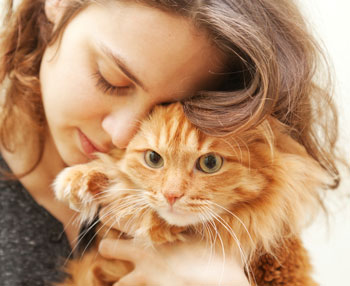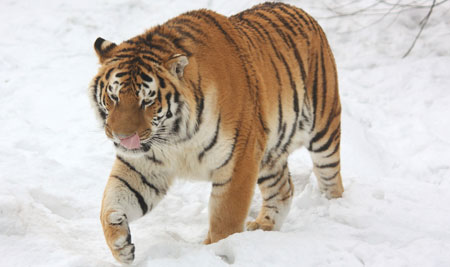Cats big and small

There are probably 600 million to 1 billion cats in the world, including 100 million wild cats such as lions and tigers.1 And the familiar domestic cat is probably to be “the most popular pet in the world”—a total of 373 million pet cats,1 despite the fact that they “contribute virtually nothing in the way of sustenance or work to human endeavour.”2 This helps explain why there is much less variation in domestic cats than in dogs. The diversity of canine sizes, shapes, and temperaments reflects the fact that people have long selected and bred dogs for such tasks as guarding, herding, hunting, and sled-pulling. Cats on the other hand, which according to Scientific American, “do not take instruction well”,2 have not been subjected to the same selective breeding pressures. While domestic dogs can look completely distinct from their ‘ancestral wolf’ form, many house cats are hard to distinguish from the wildcat3—with which they readily interbreed, and share the same species name, Felis silvestris.

How many cats on the Ark?

All the cat species alive today can interbreed, even between genera and subfamilies of the family Felidae. So this suggests that all living members of Felidae descended from a pair of one original cat (‘felid’) kind that Noah took on the Ark (see Figure 1).
Many people know that cats were worshipped as gods in Egypt, but that was not where they were originally tamed. Based on DNA similarity, researchers say that all domestic cats are descended from a small family of cats “living on the banks of the Tigris and Euphrates.”5,6 It was there that cats first began “to take advantage of the mice and food scraps” near human settlement.2 It is also the general area where Noah’s descendants settled after the Flood (Genesis 11:2).
The Middle Eastern wildcat is anecdotally less flighty and more tolerant of humans than other wildcat subspecies. Scientific American noted: “in the lingo of evolutionary biology, natural selection favoured those cats that were able to cohabit with humans and thereby gain access to the trash and mice.”2 Actually, natural selection has nothing to do with ‘evolutionary biology’, because natural selection is simply a favouring of a subset of existing genetic information. In contrast, the supposed evolution pathway from primordial cell to Persian cats, pumas and panthers requires an increase in genetic information.7,8
Did you select your ‘household mouse exterminator’ or did it select you?
Cats were almost certainly ‘kept around’ by people initially because of their incredible hunting instinct. Killing mice and other pests would have been a tremendous benefit. However, this function did not require them to work closely with ‘their’ humans, as dogs did when they were domesticated, so they were not domesticated to the extent that dogs were.
Though often aloof, cats can be irresistibly affectionate to people they like. And examples abound of the incredible loyalty of cats towards the people in their household—e.g. the oft-viewed videoclip of the seven-year-old Californian boy being rescued from a savage dog attack by his pet cat ‘Tara’.9

A vegetarian carnivore?


Normally, cats are ‘hypercarnivorous’, though they do need greens as part of a balanced diet (which is normally included in cat food). They normally cannot survive on plants alone, and may become very ill if they are fed a vegan diet, as they cannot synthesize their own vitamin D, arachidonic acid (needed for wound healing), and taurine (maintenance of the retina, and heart function). Cats can become very ill, suffer eye problems, or even die if they do not eat animal-based food.


This makes cats who refuse to eat meat altogether even more remarkable. A two-year-old British pet cat called ‘Dante’ was reported to be exclusively (and resolutely) vegetarian.10,11 And there have been at least two famous big cats, ‘Little Tyke—the lion that wouldn’t eat meat’ and ‘Lea, spaghetti lioness’, being exclusively vegetarian.12,13,14 However, the Bible tells us that cats were originally created vegetarian (Genesis 1:30) and it also speaks of a time when “the lion will eat straw like the ox” (Isaiah 11:7, 65:25). In that light, today’s instances in nature of vegetarianism, altruism and other evolutionary anomalies can instead be much more readily understood as ‘echoes’ of a formerly “very good” creation (Genesis 1:31). A creation now in serious “bondage to decay” (Romans 8:19–22), where even ‘9-lives’ cats suffer mutations (see Cat mutation).
One leading creationist thinker11 has suggested vegetarian-capable cats might be examples of ‘reverse mutations’15 restoring the feline ability to synthesize the needed body components from the raw materials ingested as plant material, thus removing the ‘drive’ to eat meat.16 Far from supporting an evolutionary story of origins, cats big and small actually demonstrate in many ways the truth of the Bible—God’s Word.
Cats glorify the Creator—the God of the Bible
In the Bible, God uses big cats—primarily lions—to make several important teaching points, e.g., to highlight David’s selfless courage (1 Samuel 17:34–37), and even as agents of God’s judgment (2 Kings 17:24–25). There are over a hundred references to big cats in Scripture; some speak of power (e.g. Proverbs 20:2, Hosea 13:7), others of uncommon restraint (Daniel 6, 1 Kings 13:28). How wonderfully emblematic of the single greatest historical figure ever: “the Lion of Judah” (Genesis 49:9–10, Revelation 5:5), our Loving Saviour Jesus Christ—Creator and Lord of all.
References and notes
- Osborn, J.F., How many cats are in the world? A Statistical Overview, World Animal Foundation, 23 Sep 2023; worldanimalfoundation.org. (Thanks to Kathy A. Miller, Asst. Outreach Manager, World Animal Foundation, for alerting us to this page.). Return to text.
- Driscoll, C., Clutton-Brock, J., Kitchener, A., O’Brien, S., The taming of the cat, Scientific American 300(6):68–75, 1 June 2009. [Subsequently published online with the altered title: “The evolution of house cats.”] Return to text.
- Especially those with coats having the distinctive mackerel-tabby pelage pattern of curved stripes. Return to text.
- Pendragon, B. and Winkler, N., The family of cats—delineation of the feline basic type, J. Creation 25(2):118–124, 2011; creation.com/cat-kind. Return to text.
- Driscoll, C.A., and 12 others, The Near Eastern origin of cat domestication, Science 317(5837):519–523, 27 July 2007. Return to text.
- English, R., Every cat traced to mother of all felines, The Advertiser (Adelaide, Australia), 30 June 2007, p. 76; cf. Catchpoole, D., Cats from Shinar, not Egypt, October 2007; creation.com/cats-shinar. Return to text.
- Ambler, M., Natural selection ≠ evolution, Creation 34(2):38–39, 2012; creation.com/nse. Return to text.
- Walker, T., Don’t fall for the bait and switch—sloppy language leads to sloppy thinking, Creation 29(4):38–39, 2007; creation.com/baitandswitch. Return to text.
- Cat saves boy from dog attack: YouTube video shows family pet rescuing child, independent.co.uk, 14 May 2014. Return to text.
- Meet Dante: Britain’s first vegetarian cat who refuses to eat meat or fish, dailymail.co.uk, 14 April 2009. Return to text.
- Wieland, C., The cat who refuses to eat meat, 28 April 2009; creation.com/vegcat. Return to text.
- Catchpoole, D., The lion that wouldn’t eat meat, Creation 22(2):22–23, 2000; creation.com/lion. Return to text.
- Catchpoole, D., Lea, the spaghetti lioness, Creation 29(4):44–45, 2007; creation.com/spag. Return to text.
- Little Tyke, like Dante the house cat, refused all offers of meat. Cf. Lea, which at seven years of age was successfully moved from an Italian zoo to a game reserve in South Africa where it made the transition to a more conventional carnivore’s diet. Return to text.
- E.g. Wieland C., At last, a good mutation? J. Creation 10(3):298, 1996; creation.com/back-mutation, reporting on: Cohen, P., Child’s lethal gene fault heals itself, New Scientist 151(2039):16, 1996. Return to text.
- Note however that such mutation repair is restorative, i.e. it in no way is the sort of genetic change that evolutionists seek as evidence of how never-previously-existing genetic information might have evolved into being. Rather, the increasing discoveries of inbuilt DNA repair mechanisms present a huge challenge to evolutionists, particularly in organisms where one or more generations have elapsed since the degradational mutation first occurred. DeWitt, D., Startling plant discovery presents problems for evolution, J. Creation 19(2):3–4, 2006; creation.com/plant-v-evolution. Return to text.












Readers’ comments
Comments are automatically closed 14 days after publication.